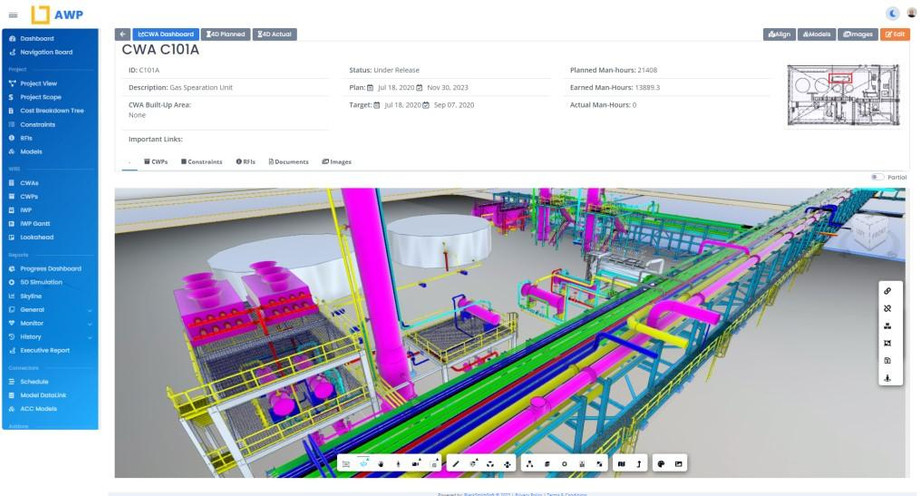In the world of complex construction and engineering projects, meticulous planning and efficient execution are essential for success. Advanced Work Packaging (AWP) is a methodology that has emerged as a game-changer in the industry, aiming to streamline the entire project lifecycle. This article will delve into the world of Advanced Work Packaging, exploring its principles, significance, and the benefits it offers to project managers, stakeholders, and the industry as a whole.
The Essence of Advanced Work Packaging
Advanced Work Packaging is a comprehensive approach that reimagines how work is planned and executed in large-scale construction and engineering projects. It combines strategy, project management, and technology to optimize project delivery. The core principles of AWP include:
Front-End Planning: AWP emphasizes thorough planning at the project's outset. This involves defining scope, objectives, and constraints to establish a clear vision for the project.
Work Breakdown Structure (WBS): Projects are divided into discrete work packages. These packages are designed to be self-contained and well-defined, simplifying work allocation and monitoring.
Work Packaging Hierarchies: AWP utilizes a hierarchy of work packages, with the top level being the project, followed by the phase, area, and ultimately, the work package. This structure ensures that work packages align with project objectives.
Workface Planning: AWP involves detailed planning at the workface level. This includes scheduling, resource allocation, and coordination to ensure that work proceeds smoothly at the execution level.
Advanced Work Packaging Software: The methodology relies on digital tools and software to facilitate planning, collaboration, and tracking of work packages.
Significance of Advanced Work Packaging
The adoption of Advanced Work Packaging has brought significant benefits to the construction and engineering industry:
Enhanced Efficiency: AWP simplifies project management by breaking down complex projects into manageable work packages. This enhances efficiency, as teams can focus on completing specific tasks with clear objectives.
Reduced Delays and Rework: Detailed front-end planning helps to identify potential bottlenecks and issues early in the project. This minimizes delays and costly rework during the construction phase.
Improved Collaboration: AWP fosters collaboration among various project stakeholders, including owners, contractors, and suppliers. Clear communication channels are established, reducing misunderstandings and conflicts.
Cost Savings: The efficient allocation of resources, reduction in delays, and minimized rework lead to cost savings. AWP helps in controlling project budgets more effectively.
Risk Mitigation: Early identification of risks during front-end planning allows project managers to implement strategies to mitigate them, ensuring a smoother project execution.
Quality Assurance: AWP ensures that work packages are well-defined, leading to better quality outcomes. The methodology helps maintain quality control throughout the project.
Sustainability: AWP encourages sustainable practices by considering environmental and social factors during project planning. This aligns with the growing focus on sustainability in the industry.
Benefits of Advanced Work Packaging
Streamlined Project Execution: AWP simplifies the management and execution of work packages, ensuring that projects proceed smoothly and efficiently.
Improved Scheduling: The methodology provides a clear and efficient way to schedule work packages, ensuring that tasks are completed on time.
Enhanced Communication: AWP fosters collaboration and communication among all project stakeholders, reducing misunderstandings and conflicts.
Risk Management: Early identification and mitigation of risks during front-end planning prevent costly issues during project execution.
Cost Control: AWP helps control project budgets through efficient resource allocation and reduced delays.
Quality Assurance: Well-defined work packages ensure that projects maintain high-quality standards.
Sustainability Focus: The methodology encourages sustainable practices, aligning with industry trends.
Challenges and Considerations
While Advanced Work Packaging offers numerous benefits, it is not without its challenges and considerations:
Change Management: Implementing AWP may require a cultural shift within organizations. Project teams need to adapt to the new methodology and technologies.
Resource Allocation: Efficient resource allocation is essential for the success of AWP. Inaccurate resource planning can lead to delays and inefficiencies.
Software and Technology: The implementation of AWP often relies on digital tools and software. Teams need to be trained and equipped to use these technologies effectively.
Data Integration: Ensuring that data flows seamlessly across various project phases and stakeholders can be complex but is essential for AWP success.
Scalability: While AWP is highly effective for large projects, its principles can be adapted for smaller projects, though the methodology may need to be scaled down accordingly.
Investment: Organizations may need to invest in training, software, and technology to successfully implement AWP.
For More Info:-
Autodesk Construction Cloud App









